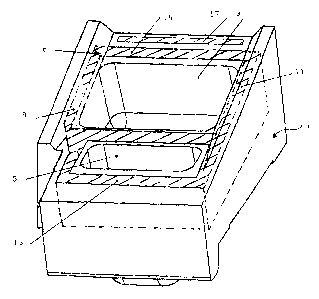Some of the information on this Web page has been provided by external sources. The Government of Canada is not responsible for the accuracy, reliability or currency of the information supplied by external sources. Users wishing to rely upon this information should consult directly with the source of the information. Content provided by external sources is not subject to official languages, privacy and accessibility requirements.
Any discrepancies in the text and image of the Claims and Abstract are due to differing posting times. Text of the Claims and Abstract are posted:
| (12) Patent: | (11) CA 2322861 |
|---|---|
| (54) English Title: | EJECTOR WITH ONE OR SEVERAL POCKETS |
| (54) French Title: | EJECTEUR A UNE OU PLUSIEURS POCHES |
| Status: | Expired and beyond the Period of Reversal |
| (51) International Patent Classification (IPC): |
|
|---|---|
| (72) Inventors : |
|
| (73) Owners : |
|
| (71) Applicants : |
|
| (74) Agent: | GOWLING WLG (CANADA) LLP |
| (74) Associate agent: | |
| (45) Issued: | 2008-05-27 |
| (86) PCT Filing Date: | 1999-03-16 |
| (87) Open to Public Inspection: | 1999-09-23 |
| Examination requested: | 2003-06-09 |
| Availability of licence: | N/A |
| Dedicated to the Public: | N/A |
| (25) Language of filing: | English |
| Patent Cooperation Treaty (PCT): | Yes |
|---|---|
| (86) PCT Filing Number: | PCT/BE1999/000034 |
| (87) International Publication Number: | WO 1999047264 |
| (85) National Entry: | 2000-09-05 |
| (30) Application Priority Data: | ||||||
|---|---|---|---|---|---|---|
|
The invention concerns an ejector with
one or several pockets, designed for centrifugal
crushers with vertical axis and having a sub
stantially parallelepiped shape, provided with a
working surface of one or several cavities (3, 5)
forming said ejector (1) pockets. The invention
is characterised in that all or part of the pocket
periphery consists of a composite material
reinforcing structure (6) itself made of an iron and
ceramic based alloy highly wear resistant and
produced in situ at the ejector spinner.
Ejecteur à une ou plusieurs poches, destiné à des concasseurs de type centrifuge à axe vertical et ayant une forme essentiellement parallélépipédique, pourvu sur sa face de travail d'une ou plusieurs cavités (3, 5) formant les poches dudit éjecteur (1), caractérisé en ce que toute ou une partie de la périphérie de la ou des poches est constituée d'une structure de renfort (6) d'un matériau composite lui-même formé d'un alliage à base de fer et de céramique très résistant à l'usure et créé in situ à la coulée de l'éjecteur.
Note: Claims are shown in the official language in which they were submitted.
Note: Descriptions are shown in the official language in which they were submitted.

2024-08-01:As part of the Next Generation Patents (NGP) transition, the Canadian Patents Database (CPD) now contains a more detailed Event History, which replicates the Event Log of our new back-office solution.
Please note that "Inactive:" events refers to events no longer in use in our new back-office solution.
For a clearer understanding of the status of the application/patent presented on this page, the site Disclaimer , as well as the definitions for Patent , Event History , Maintenance Fee and Payment History should be consulted.
| Description | Date |
|---|---|
| Time Limit for Reversal Expired | 2015-03-16 |
| Letter Sent | 2014-03-17 |
| Grant by Issuance | 2008-05-27 |
| Inactive: Cover page published | 2008-05-26 |
| Inactive: IPRP received | 2008-01-08 |
| Inactive: Final fee received | 2007-12-27 |
| Pre-grant | 2007-12-27 |
| Inactive: Adhoc Request Documented | 2007-09-05 |
| Letter Sent | 2007-09-05 |
| Notice of Allowance is Issued | 2007-09-05 |
| Notice of Allowance is Issued | 2007-09-05 |
| Inactive: Delete abandonment | 2007-09-05 |
| Inactive: Abandoned - No reply to Office letter | 2007-06-11 |
| Inactive: Received pages at allowance | 2007-06-07 |
| Inactive: Office letter | 2007-03-09 |
| Inactive: Approved for allowance (AFA) | 2007-02-12 |
| Amendment Received - Voluntary Amendment | 2006-06-07 |
| Letter Sent | 2006-05-31 |
| Reinstatement Requirements Deemed Compliant for All Abandonment Reasons | 2006-05-09 |
| Deemed Abandoned - Failure to Respond to Maintenance Fee Notice | 2006-03-16 |
| Inactive: S.30(2) Rules - Examiner requisition | 2005-12-19 |
| Letter Sent | 2003-07-16 |
| Request for Examination Received | 2003-06-09 |
| Request for Examination Requirements Determined Compliant | 2003-06-09 |
| All Requirements for Examination Determined Compliant | 2003-06-09 |
| Amendment Received - Voluntary Amendment | 2003-06-09 |
| Letter Sent | 2001-01-05 |
| Inactive: Cover page published | 2000-12-06 |
| Inactive: Single transfer | 2000-12-01 |
| Inactive: First IPC assigned | 2000-11-29 |
| Inactive: Courtesy letter - Evidence | 2000-11-28 |
| Inactive: Notice - National entry - No RFE | 2000-11-23 |
| Application Received - PCT | 2000-11-17 |
| Application Published (Open to Public Inspection) | 1999-09-23 |
| Abandonment Date | Reason | Reinstatement Date |
|---|---|---|
| 2006-03-16 |
The last payment was received on 2008-02-27
Note : If the full payment has not been received on or before the date indicated, a further fee may be required which may be one of the following
Please refer to the CIPO Patent Fees web page to see all current fee amounts.
Note: Records showing the ownership history in alphabetical order.
| Current Owners on Record |
|---|
| MAGOTTEAUX INTERNATIONAL S.A. |
| Past Owners on Record |
|---|
| CLAUDE PONCIN |